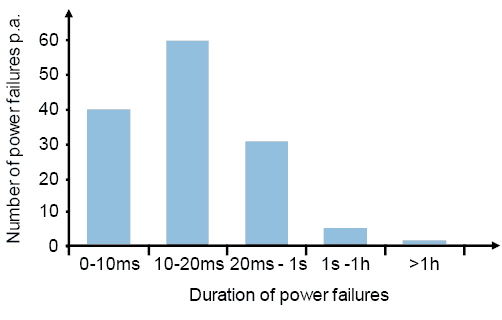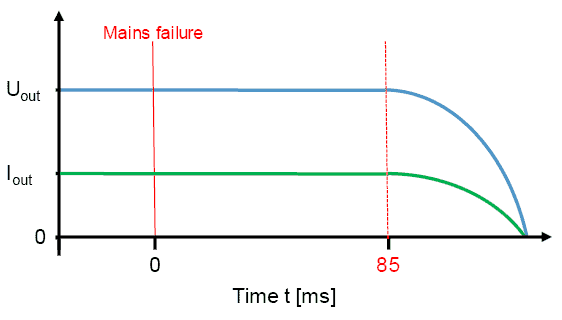Investigation of the dropout stability of the PS2000OEM power source during operation
This paper describes the investigation of the probability of failure of the PS2000OEM power source in the event of a short-term power failure of the power grid. The tests carried out and the probabilities of grid failures in Europe are shown. The result can be transferred directly to practical applications and shows the resistance of the PS2000OEM to power failures.
In European countries, especially in Germany , power failures hardly occur any more. Regardless of this, network fluctuations or very short network breakdowns can occur, which are hardly or not at all noticeable. Figure 1 clearly shows that about two thirds of grid failures do not exceed a duration of t=20 ms. Based on this, a test setup was prepared to demonstrate the dropout stability of the PS2000OEM. It is examined how long the PS2000OEM can be supplied by the internal capacities in the event of a power failure. It will be shown that the PS2000OEM can maintain operation for a certain time without being supplied from the mains.

Experimental setup for measuring dropout stability
The experimental setup consists of a PS2000OEM, a Tektronix DPO3034 4-channel oscilloscope, two high voltage probes (T1, T2) and a current probe (T3). The first high voltage probe (T1) measures the mains voltage. Current and voltage are measured on the output side of the high voltage cable (HVC) when operated with a PG31 plasma generator. For mains voltage measurement, a banana plug is inserted into the phase contact (L1) of a Schuko multiple socket with switch (S1). The grounding point of the second high-voltage probe is the grounded housing of the PS2000OEM. The measurement takes place during operation. The switch-off time was arbitrarily selected in the middle of the recording data. The recording parameters are current and voltage of the PS2000OEM output side and mains voltage of the PS2000OEM input side. The following figure schematically shows the test setup.
![Schematischer Versuchsaufbau mit Versorgung aus dem Stromnetz, Stromquelle PS2000OEM [1], Hochspannungskabel [2], Plasmaerzeuger PG31 [3], Oszilloskop Tektronix DPO3034 sowie Tastköpfen (T1, T2, T3)](https://www.relyon-plasma.com/wp-content/uploads/2019/03/Schematischer_Versuchsaufbau.png)
Measurement series for time determination of dropout stability
Oscilloscope recordings of the output voltage U_out and the output current value I_out after the abrupt failure of the mains voltage, simulated by switching off the PS2000OEM at the front switch as well as by opening the switch of the multiple socket show the behaviour outlined in Figure 3.

Up to approx. t=60 ms after power failure a stable burning behaviour of the arc and the discharged plasma flame can be observed, after t=85 ms the arc breaks down. The capacity integrated in the pulsed high-voltage supply and the power control ensure process stability for this period.
Measurement of failure probability of microcontrollers and bus communication
Previous data provide information on the behaviour of electric arcs and plasma formation. Furthermore, the behaviour of CAN communication [4] is to be investigated on a microcontroller basis in order to be able to rule out possible malfunctions. A HIL test in conjunction with an EATON EC4P-221-MTXD1 shows the reconnection after the PS2000OEM supply voltage has been disconnected. The supply of the communication controllers is based on successively connected voltage converters (U_1=230 V AC, U_2=24 V DC, U_3=5 V DC) with connected capacitors. With a CAN heartbeat of t=2000 ms and a downtime of t_(max,drop)=60 ms the failure probability of the communication results to P_drop=(85 ms)/(2000 ms)=4,25 %. An improvement is achieved by cyclically sending the safety-relevant commands (switching off the high voltage) as well as the heartbeat or node guarding signal. If the assumed failure probability is reduced by half and the maximum failure time of the mains supply is considered, a failure probability P_(drop,real)≪1% results in the event of a mains failure.
A further issue would be the failure of a built-in controller under the assumption that the other controllers are still ready for operation. The SPI communication is monitored internally, so that in the event of an internal communication failure between n≥2 microcontrollers, the generation of the high voltage is immediately stopped and the power source switches to the fault state.
Conclusion
As the maximum time of a power failure that does not affect the functionality of the PS2000OEM power source, the value is approximated to t=85 ms. This means that at least two thirds of all power failures have no effect on operation.
This shows the stability of a PS2000OEM power source against short-term mains failures or mains fluctuations and thus guarantees safe handling in in-line operation. Even in the event of a failure of the microcontrollers installed, the high voltage is safely switched off in the event of a brief voltage drop.
Literaturverzeichnis
1) Krisenforscher zu Stromausfall in Deutschland, unter https://www.welt.de/vermischtes/article160308959/Irgendwann-bricht-das-oeffentliche-Leben-zusammen.html (14.03.2019)
2) Nach D. Eisermann, „Versorgungssicherheit durch unterbrechungsfreie Stromversorgung“, Elektropraktiker, Berlin 54 (2000) 4
3) Technische Beschreibung unter http://de.rs-online.com/web/p/prozessmodule/0133276/ (14.03.2019)
4) Handbuch unter ftp://ftp.moeller.net/DOCUMENTATION/AWB_MANUALS/MN05003003Z_DE.pdf (14.03.2019)
5) Node Monitoring via Node-Guarding or Heartbeat Messages, unter: https://www.canopensolutions.com/english/about_canopen/Heartbeat-service.shtml (14.03.2019)




